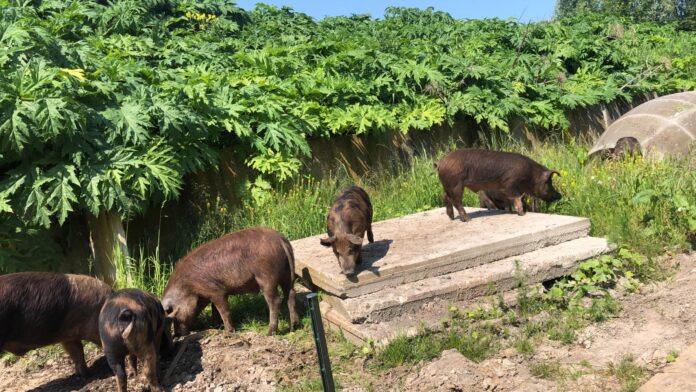The pigs who have been removing invasive hogweed and Japanese knotweed on Zernike Campus may be coming back after all. The return of the pigs is one of two solutions the UG seems to be actively considering.
The other one is freezing of the infected soil to kill the weeds. The method is effective, but pricey with a one-off fee of 36,000 euros.
Another problem is that it kills all the other plants that share the soil with the weeds. They will grow back, though, as they are reintroduced naturally over time from their surroundings, says Chris van Dijk, who researches sustainable green management at Wageningen University and advises municipalities on how to deal with Japanese knotweed and other invasive species.
However, that also means the knotweed and hogweed can come back in the same way.
Volunteers
Bringing back the pigs – who are rented from Akkervarken in Valthermond – would cost 4,500 euros per year with an additional cost for extra food for the pigs – they don’t live on hogweed alone.
In the past that cost an additional 10,000 euros. ‘For a period of six to seven months, we had to go every day from Valthermond to Groningen to feed them for ten minutes’, says owner Willem Hempen from Akkervarkens. ‘You can do the math.’
However, other companies renting pigs use volunteers. Some inside the UG had suggested doing the same, as it would reduce the extra costs by thousands. But then the decision was made not to use pigs at all anymore.
Meeting
Hempens contradicts sources saying the pigs work only for hogweed and not for knotweed. To kill off the hogweed, they need two years. Japanese knotweed takes them five. ‘Right now they have only been there for three’, Hempens says.
The university will meet with him later this month and a decision will be made about how to proceed, according to UG spokesperson Elies Wempe-Kouwenhoven.
Commotion
The UG originally wanted to replace the pigs with a more permanent solution to the problem. This caused a commotion within the UG community and many people asked for the pigs to return.
Regardless of what new method is chosen, it needs to be put in place soon. The weeds are growing rapidly and will produce thousands of seeds and spread even further if they are allowed to bloom. Hogweed starts flowering in July, knotweed in August.




